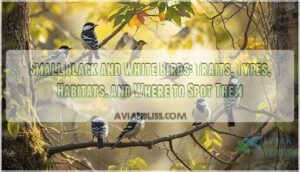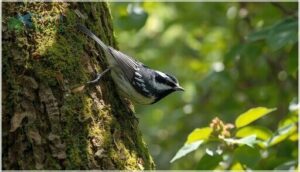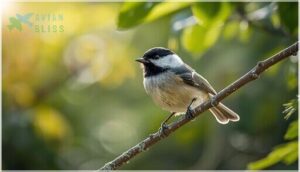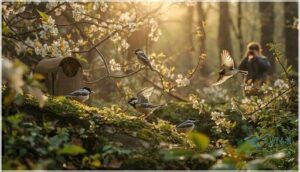This site is supported by our readers. We may earn a commission, at no cost to you, if you purchase through links.

You might notice a flash of stripes through the branches and wonder what just darted past your window. Small black and white birds show up in backyards, forests, and parks across North America, their bold patterns making them surprisingly easy to spot once you know what to look for.
These pint-sized species—ranging from chickadees to warblers—aren’t just striking to watch; their colors serve as nature’s identification tags, helping you distinguish one bird from another. Each species carries its own set of quirks, from the way it clings to tree bark to the calls it makes at dawn.
Understanding their traits, habitats, and behaviors turns casual birdwatching into a rewarding skill that deepens your connection to the natural world around you.
Table Of Contents
- Key Takeaways
- What Are Small Black and White Birds?
- Types of Small Black and White Birds
- Habitats and Distribution Patterns
- Behavior, Diet, and Ecology
- Conservation and Birdwatching Tips
- Frequently Asked Questions (FAQs)
- What do small black and white birds primarily eat?
- How do black and white birds adapt to urban environments?
- What are the distinctive courtship rituals of black birds?
- How do I identify a black and white bird species?
- What are the unique migration patterns of small black birds?
- How do black and white birds attract mates?
- How long do these birds typically live in the wild?
- Can black and white birds hybridize with other species?
- What diseases most commonly affect these bird populations?
- Conclusion
Key Takeaways
- Small black and white birds are easy to spot thanks to their bold patterns, with each species showing unique markings, behaviors, and calls that help you tell them apart.
- These birds play crucial roles in their ecosystems by controlling pests, spreading seeds, and supporting soil health through their daily activities.
- Habitat loss, climate change, and urban development are pressuring many species, making conservation efforts and community involvement essential for their survival.
- If you want to identify and enjoy these birds, focus on their size, plumage, calls, and the time of day, using simple tools like binoculars and field notes to sharpen your skills.
What Are Small Black and White Birds?
Small black and white birds catch the eye with their striking colors and unique patterns. You’ll find that each species has its own set of traits and quirks that make it stand out.
Here’s what to look for as you explore the different types up close.
Defining Characteristics and Plumage Patterns
Picture a flash of contrast darting through the trees—that’s the essence of small black and white birds. Their patterns—stripes, caps, masks—serve as nature’s code for quick bird identification.
Underneath, achromatic layers shape Plumage Dichromatism and drive Color Evolution. These feather arrangements act like fingerprints, letting you spot avian species and master pattern recognition in the field.
A Downy Woodpecker, for example, has distinguishable black bars on its white tail feathers.
Common Physical Traits and Size
Now let’s talk size. Most small black and white birds measure between 11–17 cm in length, with body mass ranging from 8–28 g.
You’ll notice bill morphology varies—black-and-white warblers sport long, downcurved bills, while downy woodpeckers have short, chisel-shaped ones. Tail characteristics differ too, from the warbler’s short tail to the woodpecker’s stiff support structure.
Sexual dimorphism appears subtle in these avian species, though males often show slightly bolder plumage details. Some species, like the Eurasian magpie, have the ability to pass the Mirror Test.
Distinguishing Black and White Birds From Similar Species
Knowing the size and shape gives you a head start, but distinguishing black and white birds from similar species requires a sharper eye. Plumage variations matter—notice whether streaks run horizontally or vertically. Vocalization differences help too; a black-capped chickadee‘s “chick-a-dee-dee-dee” sounds nothing like a warbler’s thin “wee-see.”
Watch for these details:
- Bill length comparisons (downy versus hairy woodpeckers)
- Tail spot patterns and markings
- Behavioral patterns like trunk-creeping versus perch-sitting
Habitat overlap complicates bird species identification, so size comparisons and foraging styles become your best tools for nailing species identification.
Types of Small Black and White Birds
Once you know what makes a bird black and white, you’ll want to meet the individual species themselves. Each one has its own unique personality, from the tree-climbing warblers to the acrobatic nuthatches.
Let’s look at some of the most common small black and white birds you’re likely to encounter in North America.
Black-and-White Warbler Identification
You can recognize the Black-and-White Warbler by its bold, zebra-like stripes covering both upper and underparts. Males sport black cheeks and throats, while females show gray cheeks with lighter markings. Their downcurved bill and extra-long hind claw help them probe bark crevices for insects, setting them apart from similar species.
Watch for their unusual nuthatch-like behavior, creeping along tree trunks and branches.
| Feature | Description |
|---|---|
| Plumage | Bold black-and-white stripes; males have black throats, females gray cheeks |
| Size | About 13 cm (sparrow-sized) with notched, square-tipped tail |
| Foraging | Creeps on tree bark like a nuthatch; rarely feeds on ground |
| Call | High-pitched “weesy-weesy-weesy” song; sharp “chit” contact calls |
Downy Woodpecker Features
You’ll recognize Downy Woodpeckers by their striking plumage variations, featuring black upperparts with a crisp white back stripe. Males display sexual dimorphism through a small red nape patch, while females lack this marking.
At just 14–18 cm long, they’re North America’s smallest woodpeckers. Notice their short, chisel-like bill morphology—much smaller than their head—and distinctive tail patterns showing black spots on white outer feathers.
Black-capped Chickadee Traits
When you spot a chickadee, you’re looking at one of the most adaptable bird species characteristics around. These black-capped chickadee beauties measure 12–15 cm long and weigh just 9–14 grams, featuring:
- Solid black cap and bib with bright white cheeks
- Greenish-gray backs and buff-colored flanks
- Vocalization frequencies from 3–4 kHz in their “fee-bee” song
- Cognitive abilities supported by enlarged hippocampus for caching
- Social hierarchy within mixed-species winter flocks
Their ecological roles include pest control and seed dispersal across diverse habitat and distribution zones.
Black Phoebe and Other Notable Species
Black Phoebe birds stand out among small black and white birds with their crisp white bellies and sooty-black heads. You’ll find these flycatchers near water sources across western North America, where they pump their tails frequently and build mud nests on bridges.
With 5 million individuals showing 2% annual growth, Black Phoebe population trends remain stable. Their habitat range extensions now reach Southern Oregon.
Habitats and Distribution Patterns
Understanding where these small black and white birds make their homes helps you know where to look for them. Their distribution spans diverse environments across North America, from dense forests to your backyard feeder, and their movements shift with the seasons.
Let’s explore the specific regions and habitats where you’re most likely to spot these distinctive species.
Preferred Environments and Regions
You’ll find these birds across wildly different ecosystems throughout the United States and beyond. Black-and-white warblers favor deciduous and mixed forests with closed canopies, particularly in the boreal hardwood shift from Minnesota to New England. Meanwhile, downy woodpeckers thrive in urban habitats and suburban settings, while black phoebes stick close to water sources at elevations between 300–2,100 meters.
Understanding these habitat preferences helps with habitat conservation efforts.
Seasonal Movements and Migration Trends
Migration timing in small black and white birds reveals fascinating patterns you can track throughout the year. Black-and-white warblers now begin spring migration approximately one day earlier each decade, a clear signal of climate trends affecting avian migration patterns across North America.
Here are five key migratory patterns in these species:
- Nighttime migration dominates – Black-and-white warblers and similar songbirds travel primarily after dark, using celestial cues and magnetic fields for navigation.
- Migration distances vary widely – Some species winter as far south as northern South America, while others shift only locally within their range.
- Peak fall movements concentrate on roughly eight non-consecutive nights, when over 50% of birds migrate in distinct pulses.
- Genetic connectivity remains strong in most populations, though some edge groups show restricted gene flow.
- Migration durations have lengthened in recent decades, with fall passages now taking longer than fifty years ago.
Understanding these migration patterns helps you predict when and where you’ll encounter different species throughout the seasons.
Urban Versus Rural Occurrences
You might wonder why your city park hosts fewer small black and white birds than rural forests—urban bird richness averages 30% lower than comparable rural sites. Greenspace dependence shapes these patterns, as species like Downy Woodpeckers need well-connected patches to thrive.
Habitat constraints and occurrence trends reveal that habitat preservation directly influences community composition, with rural areas supporting 2.5 times more black and white bird species than cities.
Behavior, Diet, and Ecology
Understanding how these small black and white birds live their daily lives gives you a deeper appreciation for what makes each species unique. Their feeding habits, calls, and interactions with their environment reveal fascinating survival strategies.
Let’s explore how they forage, communicate, and contribute to the ecosystems around them.
Foraging Strategies and Food Preferences
Understanding bird behavior patterns reveals how small black and white species adapt their feeding tactics. Bark foraging specialists like Black-and-white Warblers obtain up to 98% of their diet by probing tree trunks for caterpillars and beetles, while mixed foraging generalists such as Black-capped Chickadees shift their seasonal diet from 90% insects in summer to 50% seeds in winter.
Feeder preferences and habitat influence further shape these avian ecology strategies.
Social Interactions and Vocalizations
Beyond feeding habits, you’ll notice these small black and white birds thrive through complex social interactions and vocal communication. Black-capped Chickadees form larger flocks on warmer days, while White-crowned Sparrows show 26% site fidelity, returning to familiar wintering grounds.
Their vocalizations serve important functions:
- Black-capped Chickadees produce distinctive “chick-a-dee-dee-dee” calls
- Downy Woodpeckers drum territorially during spring breeding seasons
- Social hierarchy determines flock dynamics and feeding order
- Play behavior strengthens bonds in stable groups
- Seasonal influence shifts interaction patterns with temperature changes
Ecological Roles in Local Ecosystems
While these vocalizations help birds communicate, their real impact happens through ecosystem functions. You’ll find they’re essential for insect population control, with chickadees consuming up to 80% insects, including damaging pests.
They also drive seed dispersal dynamics for over 60 plant species, strengthen food web connectivity by supporting 10 raptor species, and boost nutrient cycling through guano distribution, adding 4–7 kg nitrogen per hectare seasonally.
| Ecological Role | Impact on Ecosystem |
|---|---|
| Insect Population Control | Reduce forest pest outbreaks by 18% annually |
| Seed Dispersal | Support regeneration of 60+ plant species |
| Nutrient Cycling | Increase soil organic matter by 12% yearly |
Conservation and Birdwatching Tips
Understanding how these small black and white birds are faring in the wild helps you appreciate the bigger picture of their survival. Some species face real challenges, from shrinking habitats to shifting climates, while others maintain steady numbers.
In this section, you’ll learn about current population trends, conservation work protecting these birds, and practical tips to spot and identify them during your own birdwatching adventures.
Population Trends and Threats
You might wonder why some of your favorite backyard visitors are becoming scarcer. Climate change, habitat loss, and pesticide impact are hammering populations hard, with some species declining up to 79% in developed areas.
Predation effects from domestic cats and nest parasites add to the pressure, threatening biodiversity and conservation across North America.
Human impact on bird populations demands urgent attention to reverse these alarming trends.
Human impact on bird populations demands urgent action to reverse alarming decline trends
Conservation Efforts and Habitat Protection
You can support conservation partnerships by protecting forest fragments over 175 hectares, which greatly boost bird presence. Habitat restoration results show species richness increases steadily in urban forests over time, while forest management policies recommend maintaining 70-hectare minimums for breeding populations.
Community engagement through citizen science programs and private landowner partnerships drives habitat preservation, strengthening biodiversity and conservation across North America’s critical ecosystems.
Best Practices for Spotting and Identifying These Birds
During those quiet morning hours, you’ll catch far more small black and white birds than at midday. Here’s how to sharpen your birdwatching skills and identification techniques:
- Use 8×42 binoculars for reliable bird species identification in dense foliage
- Learn unique calls—they boost detection by 28% for identification and recognition
- Survey within two hours of sunrise for 60% better results
- Stay stationary for 5–10 minutes to observe multiple individuals
- Document with photos and notes for verification
Choice equipment and behavioral cues transform spotting these bird species into rewarding discoveries.
Frequently Asked Questions (FAQs)
What do small black and white birds primarily eat?
Think of a bird’s menu as shifting with the seasons—most small black and white birds favor an insectivorous diet during warm months, then switch to seed consumption and berries when winter arrives, adapting their foraging methods accordingly.
How do black and white birds adapt to urban environments?
You’ll notice urban environments push birds to shift their dietary habits, embrace bolder nesting choices on buildings, and display reduced fear around people.
These population changes reflect striking behavioral plasticity in backyard birds exploring wildlife habitats.
What are the distinctive courtship rituals of black birds?
Like dancers at a masquerade ball, black birds perform elaborate courtship displays involving aerial acrobatics, ritualistic dances, and synchronized movements.
These avian species maintain pair bonds through intricate behaviors, though extra-pair copulation occurs occasionally.
How do I identify a black and white bird species?
To identify a black and white bird species, focus on plumage patterns, bird size, habitat clues, vocalizations, and distinct behavior analysis.
Comparing these traits helps you master bird identification, especially among similar small black and white birds.
What are the unique migration patterns of small black birds?
While migration timing often dances to the rhythm of seasons and food, small black birds display striking distance variability—some travel thousands of kilometers, others show only partial migration.
Environmental triggers and shifting populations shape their bird migration and habitat strategies.
How do black and white birds attract mates?
To attract mates, many bird species use visual displays, unique vocalizations and calls, gift-giving rituals, mutual preening, and impressive aerial performances. Each strategy is woven into their bird behavior and ecology, especially among small black and white birds.
How long do these birds typically live in the wild?
Think of a bird’s life as a winding forest trail—most small black and white bird species average 2–6 years in the wild, but some outliers—like the Black-and-white Warbler or Downy Woodpecker—can survive over a decade.
Can black and white birds hybridize with other species?
Hybridization frequency among avian species is surprisingly high, even for Black and White Birds. These small black and white birds sometimes produce hybrids with genetic consequences, from hybrid vigor to new speciation events, driven partly by plumage inheritance and bird behavior.
What diseases most commonly affect these bird populations?
Just under the surface, real threats loom: Avian Salmonellosis causes winter die-offs, while HPAI Impacts, West Nile, urban diseases, and mysterious paralysis syndromes shape wildlife and ecology, challenging conservation status and urgent priorities in avian biology.
Conclusion
Don’t let these “feathered enigmas” fly under your radar—the domain of small black and white birds holds more surprises than you might expect.
Pausing to notice their stripes, listen for their calls, or spot their nimble movements transforms an ordinary walk into a true adventure.
Every pattern offers a clue, every behavior unravels a story, and every encounter knits you closer to the pulse of wildness right outside your door. Curiosity, it seems, always finds its wings.










